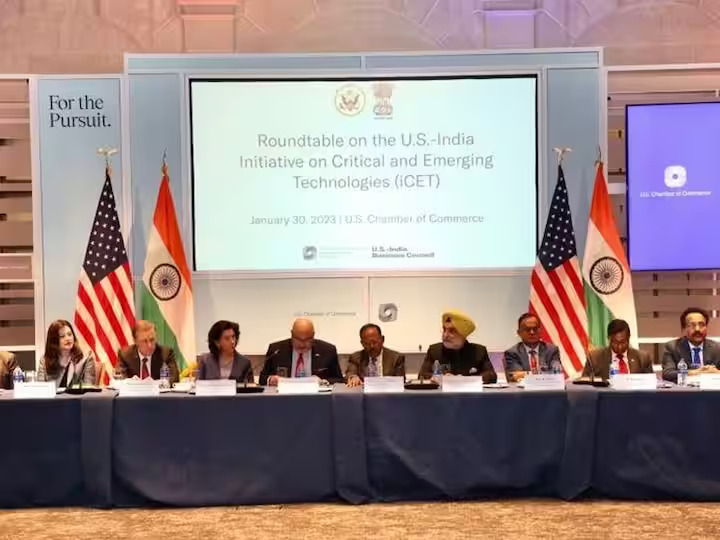The Next Phase Of U.S.-India Defence Ties
Context :
The visit of the American defence secretary earlier in June helped to set the stage for the Indian prime minister’s trip to the United States the following week, which may result in some significant announcements.
India-US relations
- Strategic Partnership: Based on shared democratic ideals, interests, and respect, India and the United States have a strategic partnership. Over time, this connection has been stronger, especially since the early 2000s.
- Bilateral trade: Trade on a bilateral basis has increased significantly between the United States and India. One of India’s biggest economic partners is the United States, and both nations have been seeking to increase their exchange of goods and services. Trade imbalances and problems with market access, however, have been of concern.
- Defence and Security Cooperation: The India-US relationship now rests mostly on defence cooperation. Both nations participate in collaborative military drills, transfers of defence technology, and information-sharing programmes. Defence connections have been strengthened further with the signing of the Major Defence Partner (MDP) designation in 2016.
- Counterterrorism: India and the US work closely together to fight terrorism. They cooperate in counterterrorism activities, share intelligence, and lend each other assistance in the fight against extremist ideology. In light of concerns about international terrorism, this cooperation has become more prominent.
- Cooperation in the Indo-Pacific: The United States and India have been collaborating to advance a free, open, and inclusive Indo-Pacific area. India, the United States, Japan, and Australia make up the Quad, which has garnered notoriety as a forum for collaboration on regional security, infrastructure growth, and economic integration.
- People-to-People Ties: There has been considerable growth in the cultural and educational contacts between the United States and India, which has led to improved intercultural understanding and stronger interpersonal ties. The American Indian diaspora has significantly contributed to the improvement of relations between the two countries.
- Climate Change and Clean Energy: The United States and India have worked together to combat climate change and advance clean energy. The framework for coordinated initiatives to cut greenhouse gas emissions and enhance sustainable development has been made possible by the Paris Agreement on climate change.
- Challenges and Areas of Cooperation: While India and the United States have achieved considerable strides in their relationship, there are still issues to be resolved, such as trade disagreements, intellectual property rights, and regional geopolitical factors. However, both nations keep trying to resolve these problems through discussion and diplomacy.
Points to Ponder:
- Strengthening Defense Industrial Cooperation :
-
-
- Defence Secretary Lloyd Austin of the United States paid a visit to India to strengthen their important defence alliance and expand collaboration in key areas.
- During the visit, a deal was reached on a roadmap for defence industry collaboration.
- The road map aims to increase technological cooperation between the two nations to increase defence manufacture in India.
-
- Initiatives for co-development and co-production:
-
-
- The road map aims to hasten measures for co-development and co-production in the defence industry.
- The goal of this project is to strengthen ties between India and the United States’ defence industries.
- Both nations may strengthen their defence capabilities and their partnership by working together on defence projects.
-
- Indus-X Initiative:
-
-
- The Indus-X initiative, which intends to give defence innovation interaction between the United States and India fresh momentum, was also launched during the visit.
- The bilateral Space Situational Awareness agreement, which was signed in 2022, is expanded upon by Indus-X.
- The programme promises to improve communication and collaboration in the space industry, particularly in sectors that are relevant to defence.
-
- Foundational Agreements and Major Defence Partner Status:
-
-
- Closer defence cooperation is possible thanks to India’s “Major Defence Partner” (MDP) designation and the four founding agreements negotiated with the United States.
- The MDP status makes it possible to exchange critical technologies without India having to officially ally itself.
- These agreements have shown to be efficient safeguards against collaboration being hampered by formal challenges or structural disparities.
-
- Focus on the Indo-Pacific:
-
-
- The United States views its defence cooperation with India as the cornerstone of its efforts in the Indo-Pacific.
- Both nations have similar evaluations of the threat, with China being cited as a major obstacle.
- China’s naval presence is anticipated to grow in the Indian and Pacific Oceans as the area becomes more volatile.
-
- The Rationale for Broader Industrial Cooperation:
-
-
- The level of American investments already made in India serves as the foundation for larger industrial collaboration between Indian and American businesses in the defence industry.
- The American government has publicly supported its corporations’ involvement in India’s efforts to modernise its military.
- The formation of joint ventures expanded American involvement in Indian defence manufacturing, and the removal of roadblocks to co-development and co-production are all possible outcomes of this collaboration.
-
- Defence Technology and Trade Initiative (DTTI):
-
-
- Despite prior difficulties, recent initiatives to encourage co-production and co-development are projected to give the DTTI more momentum.
- The iCET agreement’s enhancement of the India-U.S. strategic cooperation has given the DTTI a distinct boost.
- The goal of the CET agreement is to improve defence collaboration in the areas of critical and emerging technology.
-
- Defence cooperation and upcoming state visits:
-
- Setting the stage for Prime Minister Narendra Modi’s official state visit to the United States on June 22, the U.S. Defence Secretary’s visit is important.
- During this visit, significant developments regarding defence cooperation are anticipated.
- The potential for a powerful alliance between two major democracies is shown in the expanding defence relationship between the United States and India.





